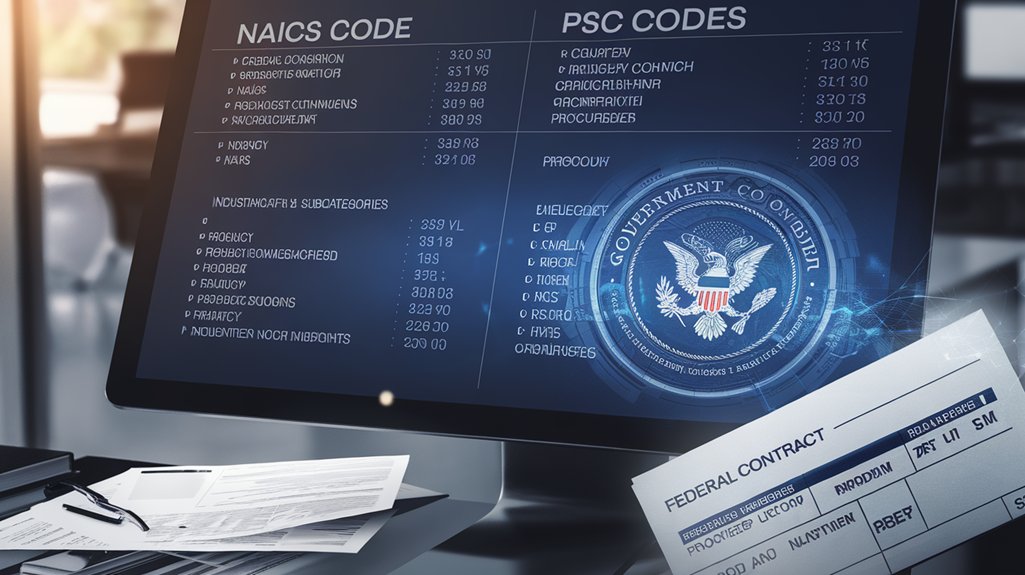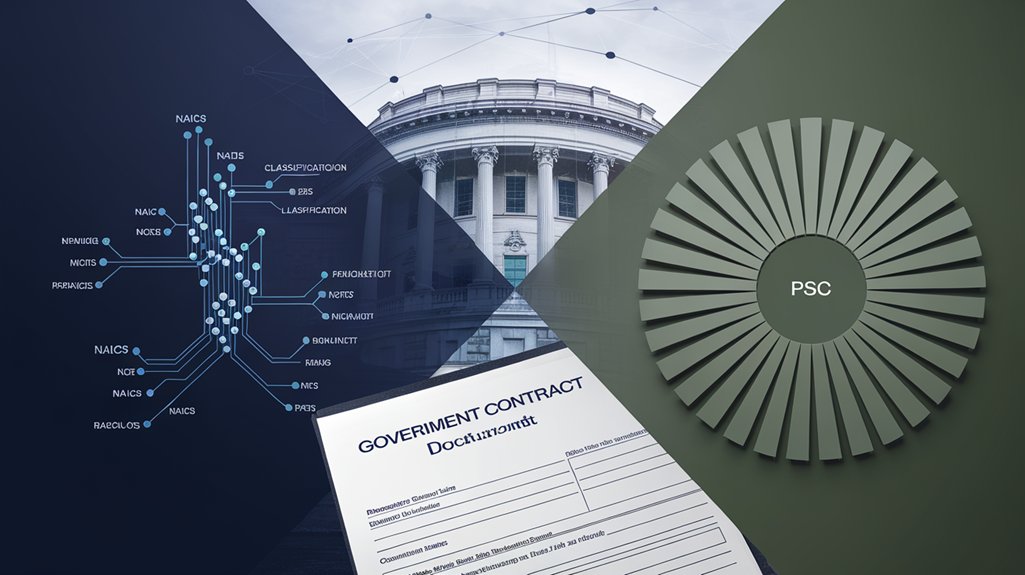NAICS codes classify businesses using a six-digit hierarchical system that determines small business eligibility, while PSC codes identify specific products and services purchased by the government with a four-character alphanumeric format. For SAM.gov registration, companies must select NAICS codes matching their primary activities, while PSC codes help target contract opportunities more precisely. Proper selection of both codes enhances visibility to government buyers and improves positioning for relevant procurement opportunities. The following sections explore strategic applications for optimizing your contracting strategy.
How NAICS and PSC Codes Fundamentally Differ

Navigational markers in the federal contracting landscape, NAICS and PSC codes serve distinct but complementary purposes for businesses and government agencies. The fundamental difference lies in their focus: NAICS codes classify business operations, while PSC codes identify specific products and services purchased by the government.
The code structure reveals their divergent functions. NAICS uses a hierarchical six-digit numeric system that groups industries by economic activity, allowing businesses to identify within broader sectors. In contrast, PSC utilizes a four-character alphanumeric format designed to pinpoint exact procurement items.
Application differences become evident in their practical use. NAICS codes determine small business size standards and eligibility for set-asides, making them essential for SAM.gov registration. PSC codes beginning with letters indicate services while codes starting with numbers represent products, creating a clear classification system for government procurement. Contract opportunities are more effectively narrowed down through PSC codes when searching for specific product or niche service areas.
PSC codes, however, track government spending patterns and help agencies filter contract opportunities by specific product types, enabling contractors to target relevant opportunities and agencies to organize procurement data efficiently. Understanding NAICS code selection is crucial for businesses seeking to accurately represent their capabilities and maximize their visibility in the federal marketplace.
Selecting the Right Codes for Your Federal Registration

The selection of appropriate codes forms the foundation of effective federal registration, directly affecting a business’s visibility and opportunity access. When approaching code selection, businesses should first identify their primary activities and match them to the most relevant NAICS codes, focusing on areas where they have demonstrated capabilities.
For PSC code optimization, companies should align choices with their specific products or services rather than broad categories. The most effective strategy involves:
- Reviewing both the PSC Manual and NAICS definitions
- Selecting codes that accurately represent core offerings
- Prioritizing codes that match targeted government procurement areas
- Limiting selections to capabilities that can be immediately delivered
Organizations should avoid selecting too many codes, which can dilute visibility in searches. Instead, a focused approach guarantees contracting officers can easily identify businesses for specific procurement needs, maximizing the potential for contract awards. Remember that your six-digit primary NAICS code is especially significant for determining eligibility for small business set-asides and other federal contracting programs. Strategic selection of secondary NAICS codes can significantly broaden your business’s market reach when your company offers diversified services or products. Unlike NAICS codes, PSC codes provide more granular descriptions of the exact products and services purchased by government agencies.
Strategic Applications of NAICS and PSC in Government Contracting

Mastering the strategic applications of NAICS and PSC codes provides businesses with powerful advantages in the competitive federal marketplace.
These classification systems serve distinct but complementary functions in contract identification and procurement processes. While NAICS codes categorize businesses by industry and determine size standards for set-asides, PSC codes describe specific products and services that match government needs.
Effective use of both code systems enhances visibility in essential procurement databases like SAM.gov and USASpending.gov.
Businesses conducting thorough market research can leverage these codes to identify relevant opportunities and assess competition in their target sectors. Proper NAICS selection is especially critical as it directly impacts eligibility for various small business set-aside programs. The standardized nature of these codes creates a common language between government buyers and vendors, streamlining the procurement process. Maintaining regular updates of your business’s registered codes is crucial to align with industry changes and maintain eligibility for new contract opportunities.
Companies that strategically position themselves using appropriate NAICS and PSC codes gain significant competitive advantages by ensuring government agencies can easily identify them as qualified providers for specific contract requirements. Contractors should study each federal agency’s trends to better align their offerings with specific government procurement patterns.
Frequently Asked Questions
Can a Business Change Its NAICS or PSC Codes After Registration?
Yes, businesses can change their NAICS or PSC codes after completing the initial registration process.
Code modification takes place within the SAM.gov entity management system, specifically under “Core Data” for NAICS codes and “Assertions” for PSC codes.
Minor updates typically reflect within 24 hours, while major changes may trigger validation workflows.
For best results, businesses should update codes at least 48 hours before bid submissions and coordinate changes with their SAM renewal cycles.
Do International Contractors Need Both NAICS and PSC Codes?
Yes, international contractors must adhere to contractor requirements when doing business with the U.S. government.
They need both NAICS and PSC codes for proper registration in SAM.gov. NAICS codes classify their business type, while PSC codes specify their products or services.
These classifications are essential for international contractors to navigate U.S. procurement systems, comply with international regulations, and gain visibility in contract opportunities.
Without proper coding, international vendors may miss relevant solicitations and face registration issues.
How Do NAICS and PSC Codes Affect Subcontractor Selection?
NAICS codes determine subcontractor eligibility through size standards, enabling prime contractors to meet small business subcontracting goals.
PSC codes, meanwhile, help identify vendors with specific technical capabilities needed for project components.
When selecting subcontractors, primes typically filter candidates first by NAICS to guarantee proper size classification, then by PSC to match precise service requirements.
Code relevance varies by procurement phase – NAICS codes dominate qualification stages while PSC codes guide technical alignment during execution.
What Happens if Incorrect Codes Are Used on Contract Proposals?
Incorrect codes on contract proposals can lead to serious consequences.
Proposal rejection may occur if the submitted NAICS or PSC codes don’t align with the solicitation requirements. Code accuracy is essential for determining eligibility, as mismatched codes can disqualify otherwise qualified businesses from set-asides.
Contractors may face protests from competitors, experience delayed contract awards, or even lose existing contracts. Additionally, regulatory non-compliance could result in penalties or exclusion from future opportunities.
Are Certain NAICS Codes More Competitive for Small Business Set-Asides?
Some NAICS codes represent more competitive industries for small business set-asides than others.
Factors affecting competition include the number of qualified small businesses in that industry, the frequency of contract opportunities, and the specific size standards established by the SBA.
Industries with higher revenue thresholds often provide small business advantages by allowing larger companies to still qualify as small.
Businesses should research competition levels within their NAICS codes when developing government contracting strategies.